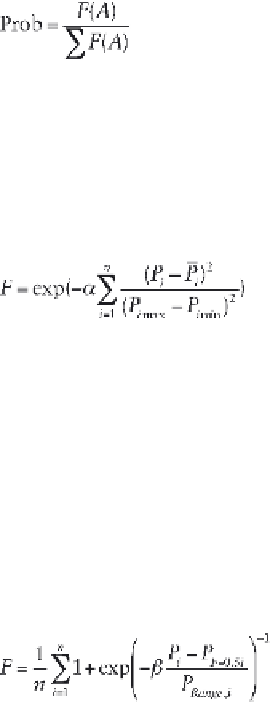Information Technology Reference
In-Depth Information
fi tness of two members of the population, retaining the fi ttest member.
Elitism is used in conjunction with other selection functions and ensures
that the best solution in any generation is automatically carried into the
next generation (Parrill, 1996).
A simple GA consists of reproductive plan and genetic operators,
cross-over and mutation (Goldberg, 1989). The probability that a
chromosome will participate in the process of creating the new generation
is proportional to fi tness criterion
F(A):
[5.21]
meaning that high-fi tness individuals will have a higher expected number
of offspring (Venkatasubramanian et al., 1994).
Different fi tness functions can be applied in GAs, depending on the
nature of the properties being studied. In the case of a target property
value with upper and lower bounds, the Gaussian function is often
employed:
[5.22]
where
P
i
is the
i
-th property value,
-
i
is the average of the maximum and
minimum acceptable property values, and
P
i
max
and
P
i
min
are used to
normalize respective property values. Fitness function
F
is a measure of
the distance of the property values of the current candidate solution
from the desired values.
F
ranges from 0 to 1, 1 being the target
fi tness, that is, the optimum solution. Parameter α determines the
fi tness decay rate, as the candidate solutions move away from the desired
ones.
When the target property value has only one bound (upper or lower),
sigmoid fi tness function can be used:
[5.23]
where
P
F=0.5
i
is the property value for which the evaluated fi tness is 0.5. It
is taken to be the lower or the upper limit of the acceptable property
constraints.
P
Range,i
normalizes the property values so as to remove any
bias of a single property on the overall fi tness. The total fi tness is taken
as the mean of the fi tness of all individual properties. Parameter β controls
the slope of the sigmoid function.





Search WWH ::

Custom Search